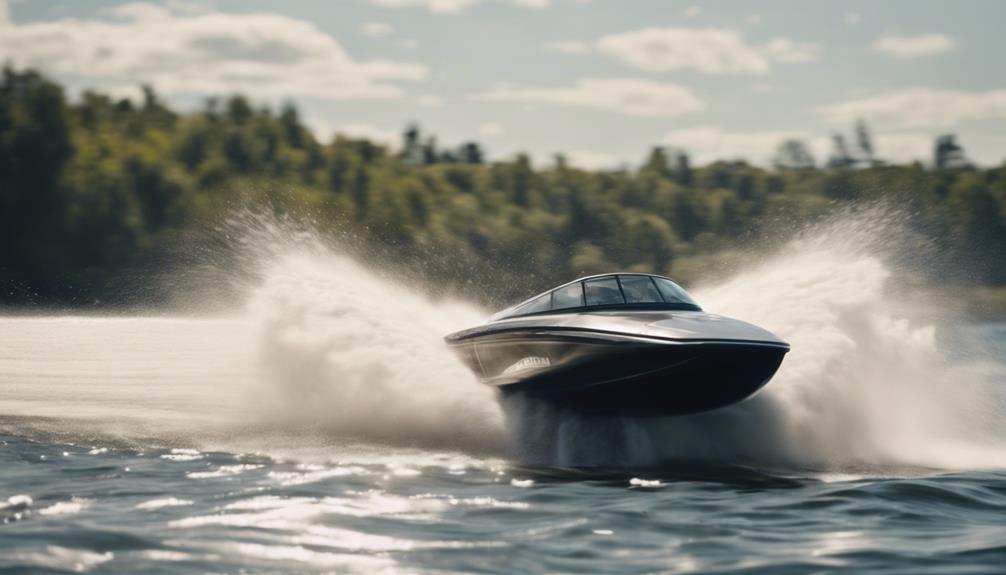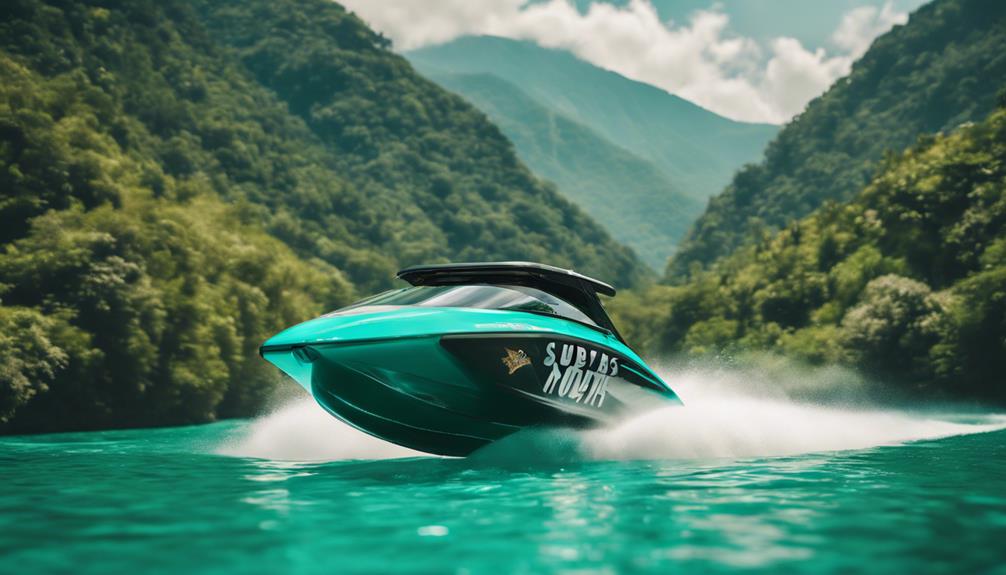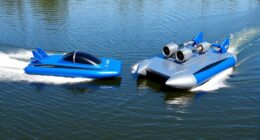Jet boats can porpoise due to various factors like weight distribution, hull design, and environmental conditions. If your boat's center of gravity is too far aft, it can lead to instability and pitching. Improper trim, especially with a heavy bow, can exacerbate this issue, even on calm water. Choppy waves and high winds can also trigger porpoising by increasing the angle of attack. Maintaining neutral weight distribution and optimizing your running trim are essential for stability. Interested in more tips to keep your jet boat steady and enjoyable on the water?
Key Takeaways
- Improper weight distribution, particularly excessive aft placement, destabilizes jet boats and increases the risk of porpoising.
- Environmental factors like wind and choppy waters exacerbate instability, causing rapid pitching moments.
- The center of gravity (CG) positioning is critical; too far aft can lead to unwanted oscillations.
- Neglecting optimal planning speed can destabilize the boat, triggering porpoising even in calm conditions.
Definition of Porpoising
Porpoising is when a jet boat experiences unstable motions, causing it to bounce up and down as it shifts between different speeds. This phenomenon typically occurs in small planning hulls, especially those ranging from 18 to 24 feet long.
As the boat shifts from displacement speed to planing speed, you might notice rapid oscillations in both heave and pitch. The center of gravity plays an essential role in this instability; if it's positioned incorrectly, it can lead to abrupt pitch changes, making control challenging.
Boat trim is another important factor. An improper trim—especially when the bow is too heavy—can exacerbate porpoising and make the ride uncomfortable. You'll find that even in calm water, porpoising can happen.
This highlights the importance of understanding both the dynamics of your boat's design and how you operate it. By adjusting your trim and ensuring the center of gravity is optimized, you can greatly reduce the likelihood of experiencing porpoising.
Awareness of these elements is vital for a smoother and more controlled ride, allowing you to enjoy your time on the water without the disruptive bouncing of a porpoising jet boat.
Factors Influencing Stability

Several key factors influence the stability of a jet boat, including weight distribution, hull shape, and the position of the center of gravity. Proper weight distribution is essential; a neutral balance helps avoid instability, while moving weight forward can reduce porpoising. The hull shape impacts resistance to porpoising, as its design directly affects performance across different speeds.
The center of gravity (CG) is another important element. If the CG is too far aft, it can trigger porpoising, while a well-positioned CG promotes lift and stability. Additionally, external factors like water surface conditions, wind, and wave action require you to adjust trim and throttle to maintain control.
Here's a quick overview of these factors:
| Factor | Influence on Stability |
|---|---|
| Weight Distribution | Affects balance; neutral is ideal |
| Hull Shape | Determines resistance to porpoising |
| Center of Gravity (CG) | Affects lift and stability; needs balance |
Hull Design Considerations

When it comes to hull design, the center of gravity plays an essential role in preventing porpoising.
You'll want to guarantee that the hull shape promotes stability while balancing lift and drag at high speeds.
Center of Gravity Impact
The center of gravity (CG) in a jet boat plays a crucial role in its stability and can greatly influence porpoising behavior. If your boat's CG is too far aft, it can cause the boat to pitch down rapidly as speed increases, leading to increased porpoising.
To maintain stability, aim for a neutral weight distribution within the hull. You can counteract porpoising effects by shifting weight forward, which helps balance the trim angle and keeps the wetted surface ideal.
As you increase speed, the relationship between the center of lift and the CG becomes critical. If the center of lift moves aft past the CG, instability may occur, making your boat more prone to porpoising.
Consequently, it's important to evaluate how weight redistribution or even modifying your engine position can enhance stability.
Hull Shape Stability
Understanding how hull shape impacts stability is vital for preventing porpoising in jet boats, as certain designs can enhance resistance to this issue while optimizing performance at high speeds. The right hull shape not only supports stability criteria but also guarantees you enjoy a smoother ride.
Here are a few key points to keep in mind:
- A flatter hull bottom can improve lift but must be balanced to avoid excessive bow lift.
- Proper weight distribution is essential; a neutral configuration helps maintain stability.
- An aft Center of Gravity (CG) might lead to pitch instability, increasing porpoising tendencies.
- Features like trim tabs or a slight negative transom angle can enhance stability, giving you better control.
When you're out on the water, a well-designed hull shape can dramatically change your experience. You want to feel confident and in control, not fighting against unwanted oscillations.
By understanding these hull shape considerations, you can select a jet boat that minimizes porpoising, guaranteeing that your adventures are thrilling, not turbulent.
Weight Distribution Effects
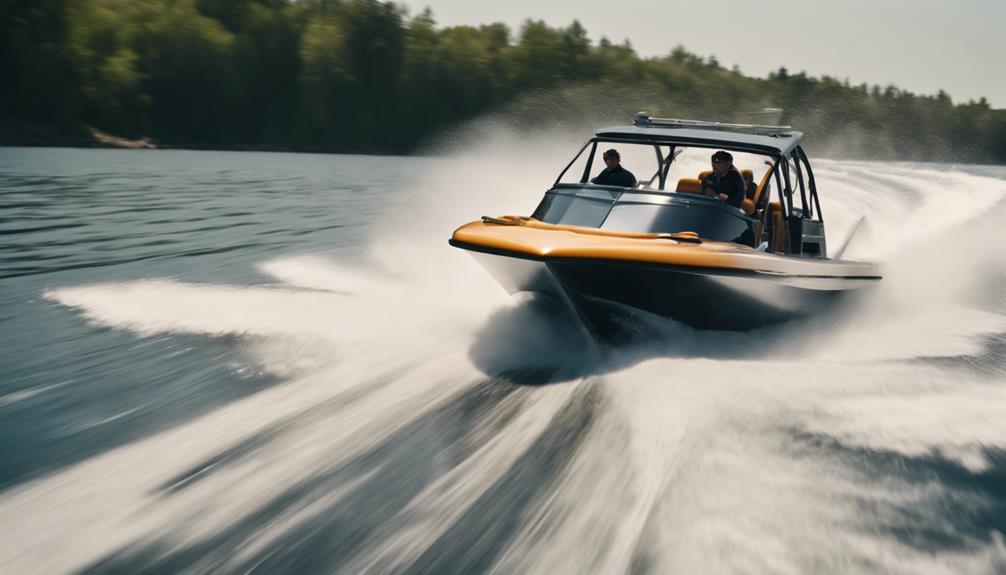
When you're on a jet boat, the way you distribute weight plays an essential role in its stability.
If you shift weight forward, it can help reduce porpoising by stabilizing the bow.
Keeping a balanced center of gravity is key to enjoying a smooth ride at higher speeds.
Center of Gravity Impact
Proper weight distribution greatly influences a jet boat's stability and can prevent the onset of porpoising. When you understand the impact of the center of gravity (CG), you can make informed choices about how to load your boat. Here's what you need to keep in mind:
- CG Placement: Moving the CG too far aft can lead to instability, causing excessive bow lift and increasing porpoising risk.
- Balanced Weight: Aim for a neutral weight distribution to minimize pitching moments and enhance stability.
- Speed Dynamics: As speed increases, the center of lift (CL) shifts aft, which can pitch your bow down if it surpasses the CG.
- Transom Weight: Excessive weight at the transom can amplify porpoising and the danger of blowovers, especially in smaller jet boats.
Weight Forward Benefits
Shifting weight forward in a jet boat can greatly enhance stability by aligning the center of gravity closer to the center of buoyancy, reducing the risk of porpoising. When you distribute weight towards the bow, it creates a longer lever arm that counteracts unwanted pitching moments. This helps maintain a more favorable trim angle, which is vital for preventing porpoising.
Properly balancing weight can also increase the wetted surface area of the hull, improving its contact with the water. This increased contact provides better resistance against porpoising by ensuring the boat stays connected to the surface. Additionally, when you minimize excessive bow lift, you enhance overall stability during operation, allowing for smoother rides even at higher speeds.
To maximize these benefits, consider adjusting your gear and equipment toward the front of the boat. This strategic weight distribution is particularly important in smaller planning hulls, where the effects of weight placement are magnified. By keeping your weight forward, you can enjoy a more stable ride while effectively mitigating the risk of porpoising, ensuring a safer and more enjoyable boating experience.
Engine Position Impact

The engine's position plays a significant role in determining a jet boat's stability and susceptibility to porpoising. When you adjust the engine height, you directly influence the center of gravity (CG) and the balance between lift and weight.
Here are four key impacts of engine positioning to take into account:
- CG Shift: A rearward CG can lead to instability, increasing the chances of porpoising.
- Trim Angle: Raising the engine alters the trim angle, helping to push the bow down and improve stability.
- Weight Considerations: Heavier outboard motors can enhance performance, but improper positioning can worsen porpoising effects.
- Dynamic Adjustments: Continuous monitoring of engine height is important; even small adjustments can lead to significant changes in boat dynamics.
Finding the right engine position is fundamental. It directly affects lift, which is essential for maintaining proper planing speed.
If you neglect this aspect, you risk destabilizing your jet boat, leading to those frustrating and sometimes dangerous porpoising moments.
Keep refining that position to guarantee smooth, enjoyable rides on the water!
Environmental Influences
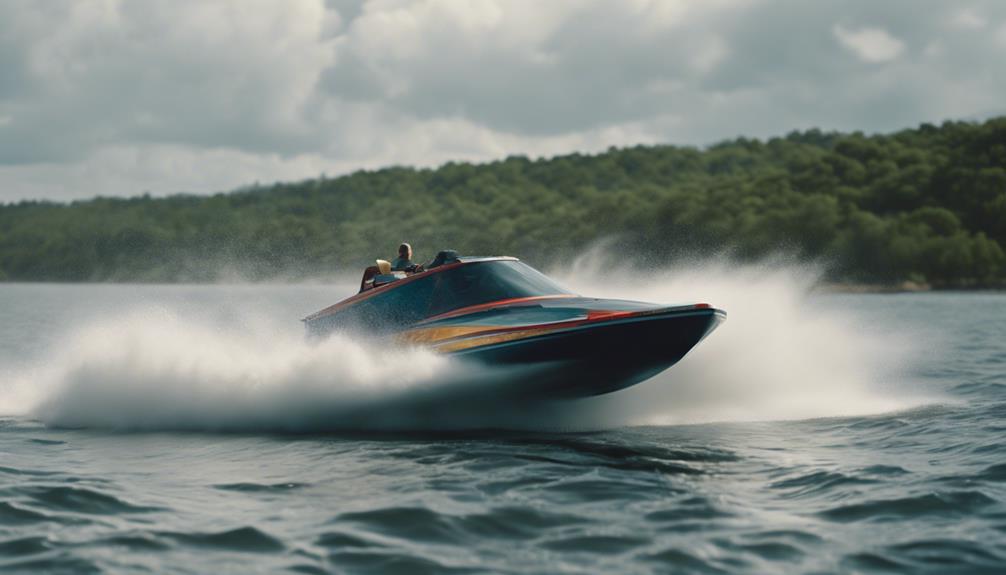
Environmental factors like wind and waves can greatly impact a jet boat's tendency to porpoise, making it essential to understand how these elements affect your ride. Choppy waters can exacerbate instability, while even smooth water can trigger porpoising if your trim and speed aren't optimized.
| Environmental Factor | Impact on Porpoising |
|---|---|
| Wind | Increases angle of attack, leading to instability. |
| Wave Conditions | Choppy water enhances pitching moments, causing porpoising. |
| Water Surface Smoothness | Affects trim optimization; smooth water can still cause issues. |
Headwinds can also contribute to blowovers at lower speeds, making it paramount to adjust your trim settings accordingly. Maintaining a bow-down attitude can help stabilize your boat against these external forces. Additionally, the interaction between your boat's hull design and environmental conditions, such as currents and swells, plays a significant role in how stable your ride will be. By understanding these environmental factors, you can better manage your jet boat's performance and reduce the likelihood of porpoising.
Solutions to Mitigate Porpoising
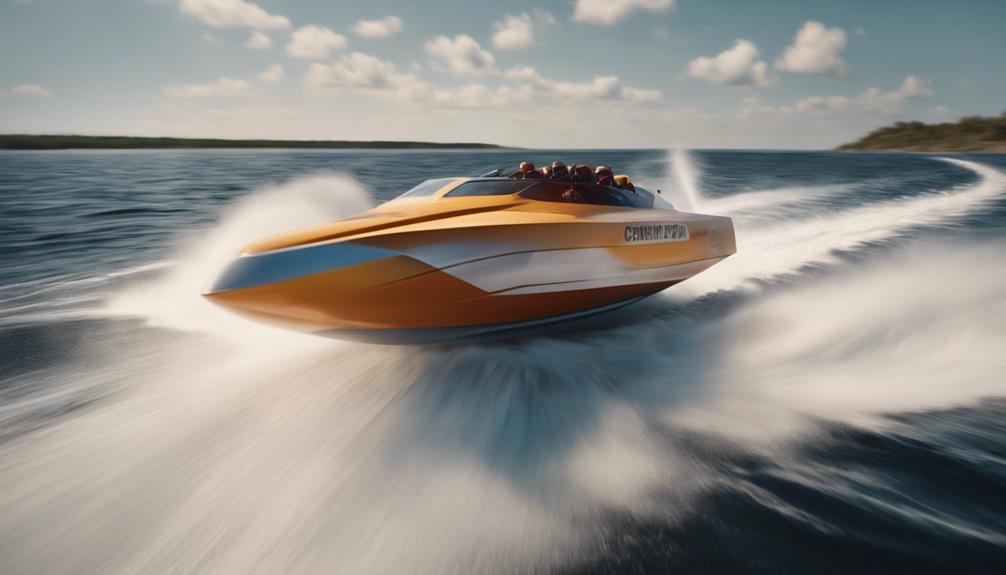
To effectively reduce porpoising in your jet boat, consider adjusting the ride plate angle to 2.5 to 3 degrees up from flat, as this optimizes water flow dynamics. You can also enhance stability by installing trim tabs on the transom, which allows better control over your boat's attitude in the water.
Here are four key solutions to mitigate porpoising:
- Adjust Weight Distribution: Shift weight to the front of the boat to stabilize it and increase wetted surface area.
- Monitor Running Trim: Regularly check and adjust your trim settings. Lower trim settings can help reduce the tendency to porpoise.
- Install Trim Tabs: These can greatly improve hull stability and help you maintain a smoother ride.
- Consider a Cavitation Plate Fin: Although it may slightly reduce top speed, it forces the bow down, aiding stability.
Technical Adjustments for Performance

Adjusting technical aspects of your jet boat can greatly enhance its overall performance and stability on the water. One of the key adjustments involves trim positioning. Lower trim settings can help mitigate porpoising, while the ideal setting varies based on your boat model and speed.
Raising the ride plate to 2.5 to 3 degrees above flat can considerably improve stability by ensuring proper water flow management and reducing the likelihood of porpoising. Installing trim tabs on the transom allows you to adjust the hull's attitude, effectively forcing the bow down during operation to lift forward and minimize porpoising.
Here's a quick reference table for technical adjustments:
| Adjustment Type | Impact on Performance |
|---|---|
| Ride Plate Angle | Enhances stability, reduces porpoising |
| Trim Positioning | Mitigates porpoising, varies by model |
| Trim Tabs | Provides hull attitude control |
Community Insights and Resources
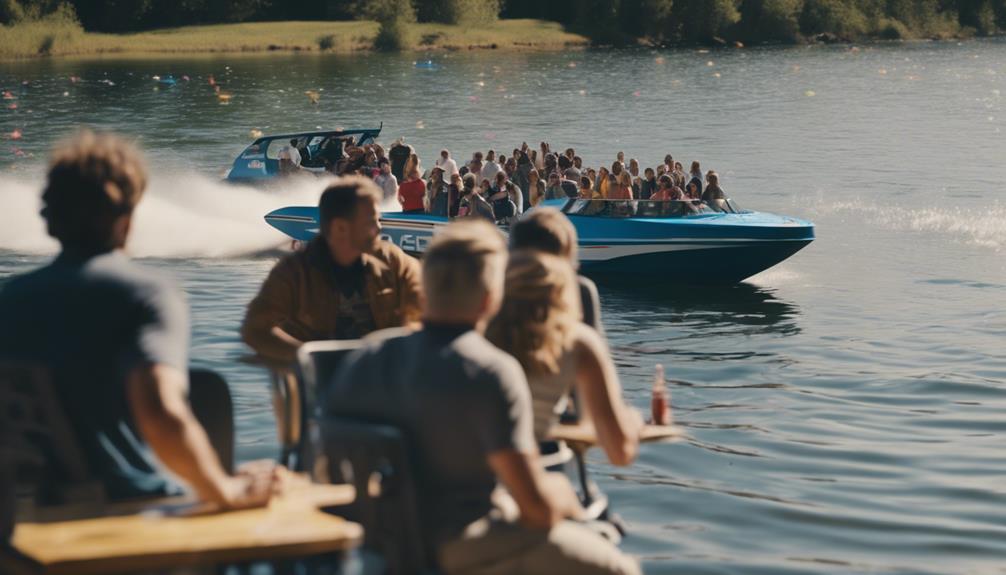
Exploring community insights and resources can provide you with valuable strategies and firsthand experiences to combat porpoising in your jet boat. Engaging with forums like Jet Boating New Zealand (JBNZ) can help you tap into a wealth of knowledge from fellow enthusiasts who've faced similar challenges.
Here are four key takeaways from the community that can make a difference:
- Weight Distribution: Make sure your load is balanced. Uneven weight can exacerbate porpoising.
- Hull Design: Understand how your boat's hull affects performance. A well-designed hull can minimize instability.
- Trim Tabs: Installing trim tabs can greatly help adjust your boat's angle, reducing porpoising.
- Networking: Connect with experienced builders and designers. Their insights can prevent costly mistakes.
Utilizing these resources and insights will empower you to navigate the complexities of porpoising effectively. By learning from those who've already tackled these issues, you'll enhance your jet boating experience and enjoy smoother, more stable rides on the water.
Frequently Asked Questions
What Causes a Jet Boat to Porpoise?
Jet boats porpoise due to an unstable center of gravity, insufficient lift, and inadequate wetted surface area. Adjusting weight distribution and considering environmental factors can help you minimize this oscillation and improve your ride stability.
How to Stop Porpoising on a Jet Boat?
To stop porpoising on your jet boat, adjust the ride plate angle, fine-tune the trim settings, and consider adding trim tabs or a fin. Regularly test these adjustments for peak performance in varying water conditions.
What Causes an Aircraft to Porpoise?
When it comes to aircraft porpoising, you're walking a tightrope. It happens when pitch oscillations occur due to improper weight distribution or control inputs, leading to instability. Keep your speed and trim in check to avoid trouble.
How to Keep a Bass Boat From Porpoising?
To keep your bass boat from porpoising, balance the weight distribution slightly towards the bow, adjust the trim angle downwards, install trim tabs, and choose an appropriate propeller for better stability at higher speeds.
How Can a Stomp Grate on a Jet Boat Cause Porpoising?
The design of the stomp grate on jet boats can sometimes cause porpoising, as its structure and location can disrupt the water flow underneath the boat, leading to an uneven weight distribution. This imbalance can result in the boat bouncing up and down on the water, causing porpoising.
Conclusion
To summarize, understanding what causes a jet boat to porpoise can save you from a bumpy and frustrating ride!
By considering factors like hull design, weight distribution, and environmental conditions, you can keep your boat stable and enjoyable.
Remember, a few technical adjustments can work wonders, almost like casting a magic spell on your performance!
So, stay informed and take action to guarantee smooth sailing on the water, and you'll never have to deal with porpoising again!

